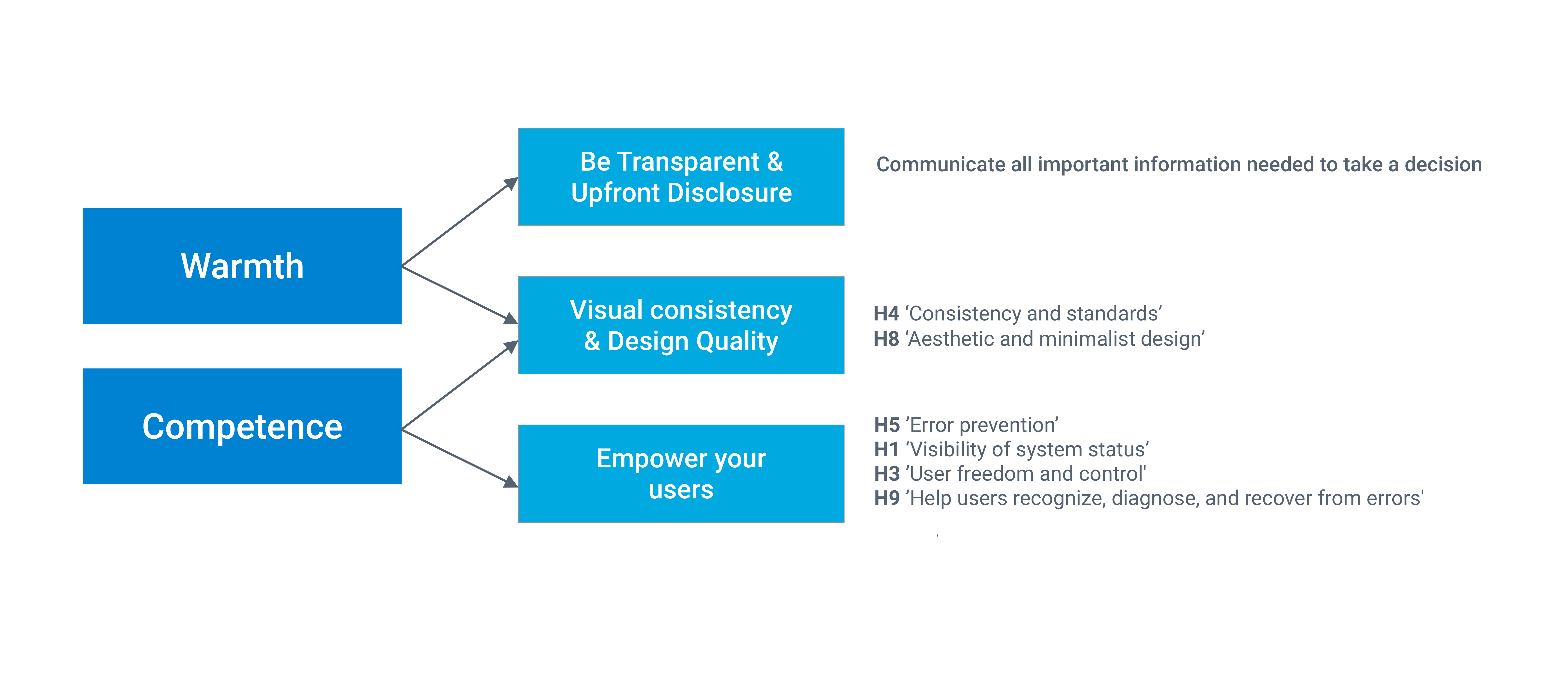Computers are an essential part of our lives and are now being treated as social actors in a way similar to how we perceive other humans. The feeling of trust is not limited to humans anymore. It can be said that the core of human-computer interaction is the feeling of trust. The primary question here is how knowledge of human behavior can help us design better products.
Importance of trust in human lives
Erik Erikson’s describes trust as the initial psychosocial crisis in his stages of psychosocial development. As infants, we are required to learn who to trust around us. Later on, in our lives, trust becomes a very important element in our decisions. It is a fundamental part of all human relationships, including friendships, romantic partnerships, family life, business operations, politics, financial decision, and medical practices.
Dimensions of Trust
Humans commonly interpret the behavior of others based on two underlying universal dimensions of social cognition, that is, warmth and competence.
Warmth is associated with perceived trustworthiness, friendliness, empathy, and kindness. It reflects perceptions of behavioral intentions. In human-computer interaction, warmth can be defined as a feeling of confidence in a product, that it will help users achieve the desired goal without deceiving them. Warmth can be a feeling that the product has your best interest at heart.
Warmth is tightly aligned with the overall user experience. It is affected by overall design quality and visual consistency. Users believe in good intentions of the product when all the information is provided before making any decisions. This includes details such as stating any additional fees or charges that may accompany a service, presenting links to the return policy and guarantees, or revealing shipping charges before asking for billing information. Making this important information easy to access on the website adds to a feeling of transparency and shows that you understand your users.
Competence is related to perceived intelligence, power, efficacy, and skill. It reflects the perception of behavioral abilities. For users, competence is achieved when the product has the ability to complete the task accurately and efficiently.
Competence is about the usability of products. The understanding of Don Norman’s principles and Nielsen’s ten heuristics can help us design products which can be trusted. Particularly Nielsen’s heuristics of ‘User freedom and control'( An ability to do and redo) and ‘Help users recognize, diagnose, and recover from errors’ can help designer build trust among their users. A product can be seen as trustworthy if it is empowering the user, helping them in getting their tasks done by preventing errors.
Every decision users make by using our product should enable them to move forward towards their goals. When a user cannot determine what actions produce the desired result, a gulf of execution is created that prevents them from accomplishing their goal. How much work a person must do to determine if their actions have had the desired result is termed the Gulf of evaluation. In order to empower our users, designers should work to narrow these gulfs.
Competence & Levels of Trust
In our personal relationships, sometimes being honest is more important than what a person can do for us. It is different in case of Human-Computer Interaction. (Figure 1.2) Competence becomes very important at the initial stage of building trust. Establishing trust, whether with a stranger or with a website, is gradual. Human-Computer relationship progress through the five levels of commitment, starting from the bottom, where each higher level requires all lower levels to be satisfied. I have modified Katie Sherwin’s trust pyramid to accommodate more possibilities during the interaction.
According to my research, it is safe to say the user completely trust our product if they recommend it to their friends. If users are trusting you their personal information, they are more likely to trust you with their sensitive and financial information. I combined both ‘trust with personal information’ and ‘trust with sensitive information’ at one level. And added a top level of ‘ Recommend to friends.’

On the first two levels of interaction, competence is the key to start a trustworthy relationship. If users are able to achieve the goal they are looking for, the initial level of trust is achieved. The second level of trust is established when the product provides a better solution than other products. On a higher level of trust, warmth plays an important role. If users believe that the product is transparent and has the best intentions at heart, they are more likely to trust you with sensitive information. Overall good user experience will help the user continue the connection. The highest level of trust is achieved when users start recommending your products to their friends.
Conclusion
Understanding of human behavior can help us design better products. The confidence that the product provides the best solution to the goal the users want to achieve and the feeling that the product has the best intention to serve the users are the basis of a trustworthy relationship.
For more information:
https://www.nngroup.com/articles/commitment-levels/
https://www.nngroup.com/articles/tone-of-voice-dimensions/
https://www.nngroup.com/articles/theory-user-delight/
https://www.appcues.com/blog/how-to-design-for-trust-and-keep-users-engaged-for-the-long-haul
https://medium.com/nerdwallet-design/designing-for-trust-c7455896432b
https://sympli.io/blog/2017/04/05/how-to-build-trust-with-your-users-through-design/
https://uxdesign.cc/8-ux-surefire-ways-to-design-for-trust-7d3720b57a4c
https://www.sciencedirect.com/science/article/pii/095354389390017N
https://www.simplypsychology.org/Erik-Erikson.html#trust
https://www.nngroup.com/articles/trustworthy-design/


